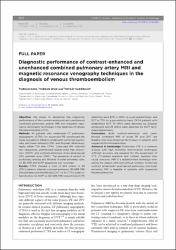| dc.contributor.author | Kaya, Furkan | |
| dc.contributor.author | Ufuk, Furkan | |
| dc.contributor.author | Karabulut, Nevzat | |
| dc.date.accessioned | 2021-05-05T22:14:17Z | |
| dc.date.available | 2021-05-05T22:14:17Z | |
| dc.date.issued | 2019 | |
| dc.identifier.issn | 0007-1285 | |
| dc.identifier.issn | 1748-880X | |
| dc.identifier.uri | https://doi.org/10.1259/bjr.20180695 | |
| dc.identifier.uri | https://hdl.handle.net/20.500.12933/414 | |
| dc.description | Ufuk, Furkan/0000-0002-8614-5387; Ufuk, Furkan/0000-0002-8614-5387 | en_US |
| dc.description | WOS:000459432000025 | en_US |
| dc.description | PubMed: 30629460 | en_US |
| dc.description.abstract | Objective: We aimed to determine the diagnostic performance of the contrast-enhanced and unenhanced combined pulmonary arterial MRI and magnetic resonance venography techniques in the diagnosis of venous thromboembolism (VTE). Methods: 44 patients who underwent CT pulmonary angiography (CTPA) for suspected PE constituted the study population. Patients underwent combined pulmonary and lower extremity MRI, and Doppler ultrasonography within 72 h after CTPA. Combined MRI included two sequences: unenhanced steady-state free precession (SSFP) and contrast-enhanced three-dimensional (3D) gradient echo (GRE). The presence of emboli in pulmonary arteries and thrombi in lower extremity veins on 3D-GRE and SSFP sequences was recorded. Results: CTPA showed a total of 244 emboli in 33 (75%) patients whereas contrast-enhanced 3D-GRE MRI showed deep vein thrombosis (DVT) in 34 (77%) subjects. Sensitivities for SSFP vs 3D-GRE MRI respectively in PE detection were 87.9 vs 100% on a per-patient basis, and 53.7 vs 73% on a per-embolus basis. Of 34 patients with established DVT, 31 (91%) were detected by Doppler ultrasound and 29 (85%) were detected by SSFP technique respectively. Conclusion: Both contrast-enhanced and unenhanced combined MRI of acute PE and DVT are feasible one-stop-shopping techniques in patients with suspected thromboembolism. Advances in knowledge: Pulmonary VTE is a common disease with high mortality. Non-invasive techniques withhigh accuracy are required for the assessment of VTE. CT-related radiation and contrast material risks cause concerns. MRI is a radiation-free technique evaluating the vessels with and without contrast. Combined contrast enhancedor unenhanced pulmonary and lower extremity MRI is feasible in patients with suspected thromboembolism. | en_US |
| dc.language.iso | eng | en_US |
| dc.publisher | British Inst Radiology | en_US |
| dc.rights | info:eu-repo/semantics/openAccess | en_US |
| dc.subject | [No Keywords] | en_US |
| dc.title | Diagnostic performance of contrast-enhanced and unenhanced combined pulmonary artery MRI and magnetic resonance venography techniques in the diagnosis of venous thromboembolism | en_US |
| dc.type | article | en_US |
| dc.department | AFSÜ, Tıp Fakültesi, Dahili Tıp Bilimleri Bölümü, Radyoloji Ana Bilim Dalı | en_US |
| dc.contributor.institutionauthor | Kaya, Furkan | |
| dc.identifier.doi | 10.1259/bjr.20180695 | |
| dc.identifier.volume | 92 | en_US |
| dc.identifier.issue | 1095 | en_US |
| dc.relation.journal | British Journal Of Radiology | en_US |
| dc.relation.publicationcategory | Makale - Uluslararası Hakemli Dergi - Kurum Öğretim Elemanı | en_US |
















